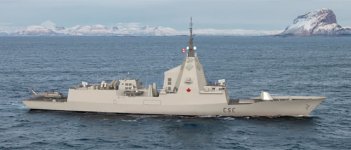Shipbuilder appeals directly to Sajjan in warship design contest then doesn't deliver formal bid
French-Italian warship design was expected to be among leading contenders in Canadian contest
Just weeks before the competition to design Canada's next warship closed, a French and Italian consortium tossed what amounts to a political Hail Mary into the bidding process for the proposed $60 billion program.
Naval Group and Fincantieri delivered its now highly-publicised, eye-popping, proposal to Defence Minister Harjit Sajjan, CBC News has learned.
The pitch, which suggested Canada could save tens of billions of dollars, appears to be a frustrating parting shot for a consortium which had been considered one of the leading contenders in the highly-anticipated program.
It was a parting shot because CBC News has learned the French and Italian consortium did not submit a formal bid by the Nov. 30 deadline to make its FREMM-class frigates Canada's new surface warships.
"Fincantieri and Naval Group have made a business decision not to submit a bid under the current Request For Proposal (RFP) issued by Irving Shipbuilding Industry," said Alix Donnelly, a spokesman for Naval Group, in an email Tuesday morning.
The decision, he added, was made after a careful evaluation.
"We have finally developed a global proposal outside the terms of the official RFP to the Ministry of Defence to meet the Canadian needs on the long term, based on our FREMM program," Donnelly said.
What the French and Italian consortium was trying to achieve by making an informal pitch to Sajjan outside of the structured bidding process, remains unclear.
In a story quoting unnamed sources, The National Post reported last week that Naval Group and Fincantieri had pitched a frigate replacement plan that would be $32 billion cheaper than the existing project estimate and involve building three of the 15 warships in Europe.
The informal proposal given to Sajjan, a copy of which was obtained by CBC News, also pledges a "fix price guarantee" and — significantly — promises to start construction of the first FREMM at the Irving Shipyard in Halifax in 2019.
It says it would charge $1.3 billion per ship, but "the final contract price will have to be defined by Irving Shipbuilding Inc.," which is the federal government's go-to yard for warship construction.
What the minister did with the pitch, dated Nov. 6, 2017, is unclear.
Sajjan's office would not answer questions on Monday and referred all queries to Public Services and Procurement Canada, which also declined to talk about the unusual proposal.
The federal government received at least three bids for warship design by the time the over 13 month competition closed, said several sources with knowledge of the file.
Among the acknowledged bidders is the Spanish-led Navantia-Saab team, which is offering its F-105 frigate design. As well, Lockheed-Martin Canada and British-based BAE Systems Inc. made headlines last week with the submission of their proposal. The third bidder remains unknown.
Federal officials made it clear previously they will not identify bidders until the process is over and a winner is declared.
Dave Perry, a defence analyst at the Canadian Global Affairs Institute, said he wasn't surprised with the latest development because the "French and Italians had been the most vocal about the problems they had with the process."
Bidders have complained Canada was asking for too much intellectual property data in its submission and there were also concerns about the transfer of top secret government-to-government information on systems such as radar and combat management equipment.
Officials close to the project, who spoke on background because of the sensitivity of the file, said dropping a proposal on the defence's minister's desk was an attempt to undermine the national shipbuilding strategy.
Perry was not prepared to go that far.
"I can't tell how much of it was a knock against the formal process; a suggestion that the current process is going to end in tears and this is a backup plan; or an acknowledgement that they [Naval Group and Fincantieri] weren't going to be successful," he said.
Industry sources have repeatedly suggested that the bidders were unhappy because they believed the process has been tilted in favour the BAE bid, which offers the Type 26 frigate, a warship that has only just entered production and has yet to establish a service history.
The Pentagon has indicated it is ready to open up its own much bigger program to replace U.S. Navy frigates to foreign warship designers.
Perry said he doesn't believe that, by itself, would have been enough to scuttle the FREMM bid.





